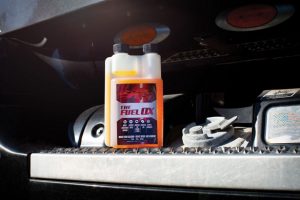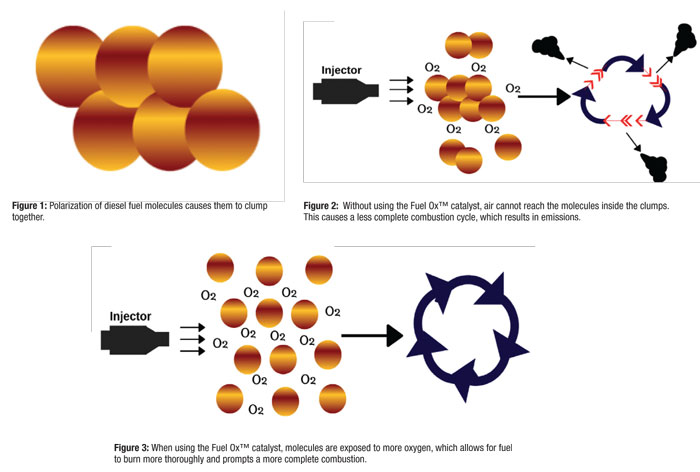Using a fuel additive enhanced with a combustion catalyst can help optimize fuel efficiency, while greatly reducing soot and emissions as well as the re-gens, repairs and other headaches that come with maintaining hard-working trucks and equipment.
By Rand Taylor
Tighter environmental standards on emissions control have put fleet operators between a rock and a hard place. While innovation in diesel technology over the past 20 years has helped us make great strides in reducing soot and other harmful emissions in the air we breathe, it has also added significant cost for truck and equipment fleet operators.
Ask any fleet manager to compare the emissions systems on today’s trucks and heavy equipment to those of just a decade or so ago and you will likely be met with groans and eye rolls before hearing a litany of problems and complaints—along with a lot of acronyms.
DPF regenerations (re-gens) keep trucks and equipment sidelined for what seems like an eternity, causing significant lost time and productivity. EGR systems are clogging up faster than an e-mail inbox when you are out of the office on vacation. DEF tanks are bottomless pits because of how much of the fluid is used in the SCR.
All diesel fleets face problems like these to varying degrees, but the waste industry is particularly susceptible. Waste trucks typically lumber through city streets and alleys, stopping from house to house, and business to business, to empty trash and recycling bins while running daily routes. Low and inconsistent speeds and long periods of idling create the perfect conditions for carbon buildup, which we commonly call “soot.” This wreaks havoc on emission systems, draining maintenance dollars and dragging down engine performance and fuel economy.

How Truck Emissions Systems Go Bad
The emission systems in today’s diesel equipment are multifaceted and complex, and each component has its own role in keeping soot and other harmful emissions from polluting our air and environment. But without preventive and routine maintenance, each of these components can create substantial headaches for the operator.
First is the diesel particulate filter, or DPF, which is designed to remove diesel particulate matter from the exhaust of a diesel engine. A typical DPF on a garbage truck accumulates enough soot in a day or two (sometimes even less) to require a re-gen, which cleans the filter by burning off the soot in the DPF. This process happens automatically in equipment that can maintain sufficiently high engine RPMs, such as over-the-road trucks. However, for many of the older trucks and equipment out there—much of which is low-speed and long-idling, like waste trucks, as well as the bulldozers and loaders used at landfills—the process is manual, which means 45 to 60 minutes of equipment downtime.
While the re-gen process itself is slightly better than it was 10 years ago (thanks to better automation) it is still highly problematic. As long as engines produce soot, the DPFs will fill up, need to go through a re-gen, fill up again, re-gen again and repeat the cycle regularly until they need to be cleaned or “baked out” by a technician. Eventually, however, they need complete replacement at a cost of usually more than $3,000 depending on the specific equipment.
The Exhaust Gas Recirculation (EGR) system, the second part of emissions control, has its own issues. The EGR diverts some of the diesel exhaust, but the soot in those emissions is also redirected back through the EGR. Over time, small amounts of soot accumulate on the EGR surface to the point that exhaust flow is hindered so much that the EGR will not work properly. Repairs can cost thousands of dollars in both parts and labor, as well as equipment downtime.
The final part of the emissions system is the Selective Catalytic Reduction (SCR) chamber, which removes the most harmful of greenhouse gases, nitrous oxides or “NOx” fumes. After passing through the DPF, where it is stripped of particulate soot, exhaust enters the SCR chamber, where it is spritzed with diesel exhaust fluid (DEF). This process converts the NOx to water that harmlessly runs out of the bottom of the SCR. While SCR failures are possible and definitely expensive, the biggest cost component of this specific process is the DEF itself. Most hardworking trucks and machinery will go through thousands of dollars of DEF alone each year.
Solving the Combustion Conundrum
While these are some of the unintended consequences operators deal with as a result of efforts to control climate change and air pollution, there are solutions that can address the source of these problems: combustion.
Soot is produced when fuel is not completely ignited in the engine cylinder during the combustion cycle. The higher the temperature, the more complete the combustion cycle, which means less soot. Unfortunately, higher combustion temperatures also create more NOx.

Solving this problem means lowering the temperature of combustion to avoid NOx while somehow optimizing that combustion so that less soot is produced—a conundrum that up until now has been nearly impossible to solve. The good news is that there are fuel additives on the market enhanced with combustion catalysts that can help address both challenges.
Fuel additives enhanced with combustion catalysts can lower the typical combustion temperatures in a diesel engine from about 900oF to about 600oF. An organometallic combustion catalyst works by breaking apart the molecular clumps in fuel, improving oxygenation, which burns more fuel, resulting in more power and better fuel efficiency while also cutting soot by at least 50 percent.
Consequently, this greatly reduces the strain on DPFs and with it the frequency of time-consuming re-gens. With less soot discharged in combustion, there is also less soot available to clog up the EGR. And because combustion catalysts reduce the temperatures required for complete combustion, less NOx is produced, which often will result in less DEF being used. Many trucking and waste companies using fuel additives enhanced with combustion catalysts have reported DEF reductions of more than 20 percent, further reducing maintenance costs.
Finding Efficiencies
In a radically altered economic environment, finding efficiencies in operations and minimizing expense on maintenance have never been more important. The complexity of emissions systems required in diesel equipment has made that task more daunting for fleet managers and equipment operators. However, using a fuel additive enhanced with a combustion catalyst can help optimize fuel efficiency, while greatly reducing soot and emissions as well as the re-gens, repairs and other headaches that come with maintaining hard-working trucks and equipment. | WA
Rand Taylor is CEO of Fuel Ox LLC(Asbury, NJ).Fuel Ox ™ is a multi-functional fuel additive that cleans, lubricates and protects vital engine components. Its proprietary, patented combustion catalyst enhances engine performance and fuel efficiency and reduces soot and emissions. Highly concentrated and 100 percent soluble, Fuel Ox is available in containers ranging from its 3-ounce OTR package formulated for single big-rig fill-ups to 1-gallon bottles that treat up to 10,000 gallons of fuel. In addition, 55-gallon drums and 275-gallon totes are available for use in filling stations and bulk terminals. If you are interested in testing Fuel Ox on your fleets and heavy machinery, call (844) 8FUELOX. Follow Fuel Ox on Facebook at facebook.com/FuelOx/, LinkedIn at linkedin.com/company/Fuel-Ox-LLC/ or Instagram at instagram.com/FuelOx/. For more information visit www.FuelOx.com.
